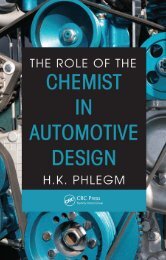Lightweight Electric/Hybrid Vehicle Design
Lightweight Electric/Hybrid Vehicle Design
Lightweight Electric/Hybrid Vehicle Design
Create successful ePaper yourself
Turn your PDF publications into a flip-book with our unique Google optimized e-Paper software.
Process engineering and control of fuel cells, prospects for EV packages 89<br />
Standard test conditions used by Ballard for SPFC stack systems are a pressure of 3 atm,<br />
stoichiometry of 2.0 for air and 1.5 for hydrogen. Their MK 513 stack is reported 9 to give 13 kW<br />
at 0.58 V and a power density of 300 W/kg and 300 W/l. The same reference quotes the performance<br />
of the stack developed for Daimler-Benz as achieving 32.3 kW at 0.68 V, and power densities of<br />
1000 W/l and 700 W/kg, which meet the target set in 1990 by the US DOE for automotive fuel<br />
cells of 560–1100 W/kg.<br />
The major challenges for fuel cells are (a) to develop systems which require similar mass and<br />
volumes to the engine plus fuel tank of current gasoline or diesel cars, at competitive prices when<br />
mass produced and (b) development of the required fuel infrastructure.<br />
4.6 Steps towards the fuel-cell engine<br />
Earlier sections of this chapter, contributed by Roger Booth, have dealt with process engineering<br />
of the fuel-cell stack. Hereafter the steps leading to the development of viable fuel-cell engines are<br />
considered. While hybrid drive vehicles, using conventional battery-electric and thermal-engine<br />
power sources, provide improved fuel economy and a viable solution for urban operation, the<br />
fuel-cell powered vehicle is now seen as the long-term option. Already it is realized that thermalengine<br />
driven vehicles can never provide the necessary fuel economy and emissions control required<br />
by world governments, primarily because the thermal engine is running at 10% of its total power<br />
potential for most of its time and there is no known way of eliminating CO emissions from it.<br />
2<br />
Over the next 20 years, people using HC vehicles are going to face increasing fuel scarcity,<br />
increasing fuel cost and ever increasing restrictions on use and size of vehicles, because of the<br />
emissions they produce. The high operating efficiency and zero emission characteristic of the<br />
fuel-cell vehicle are strong arguments for its adoption. But the passage into the period of the<br />
hydrogen-fuel economy has to be a gradual and peaceful one, requiring considerable changes in<br />
attitude by the motoring publics worldwide.<br />
4.6.1 FUEL CELLS: TOWARDS A PAINLESS TRANSITION<br />
The only way to break out of the cycle of increasing fuel costs and heavier restrictions is for<br />
motorists to accept the necessity to move over to a hydrogen-fuel economy in the shorter term and<br />
to lessen its impact by replacing their current vehicles, when the time comes, with much more<br />
fuel-efficient types. There are two advantages to the hydrogen economy: if early hydrogen-fuelled<br />
vehicles are not very efficient it does not matter because pollution-wise they have zero emissions,<br />
and more importantly, the existing cost of expensive exhaust after-treatment is removed.<br />
The publication by the OECD International Energy Agency in 1998 of ‘World Energy Outlook’,<br />
a year after the Kyoto Earth Summit, was a pivotal point in understanding world energy and<br />
pollution problems. The basic message was that, as people now live longer, energy usage and<br />
pollution rise exponentially and a ‘brick-wall situation threatening in ten years’ time means that<br />
we cannot stay as we are’. It was also from this point that the major G7 economies took global<br />
warming seriously. China, too, takes it seriously, realizing that nine-tenths of its population live in<br />
its southeastern corner delta region, which could be subject to flooding if global warming is not<br />
seriously addressed. World oil supply is expected to peak in 2010 and then tail off; this is unless<br />
the cost can be met of tapping into the vast oil deposits beneath the polar icecaps. But North<br />
American motorists remain blissfully unaware of these threatening situations. While the UK and<br />
Europe pay what gasoline and diesel actually costs, in total, US users have an enormous effective<br />
subsidy which hides the governmental costs, and keeps them oblivious to the problems involved.<br />
Fuel/vehicle taxes in the UK pay for road building, health care related to accidents, also defence<br />
costs relating to naval protection of oil rigs, whereas in the USA the petrol price paid at the pumps







